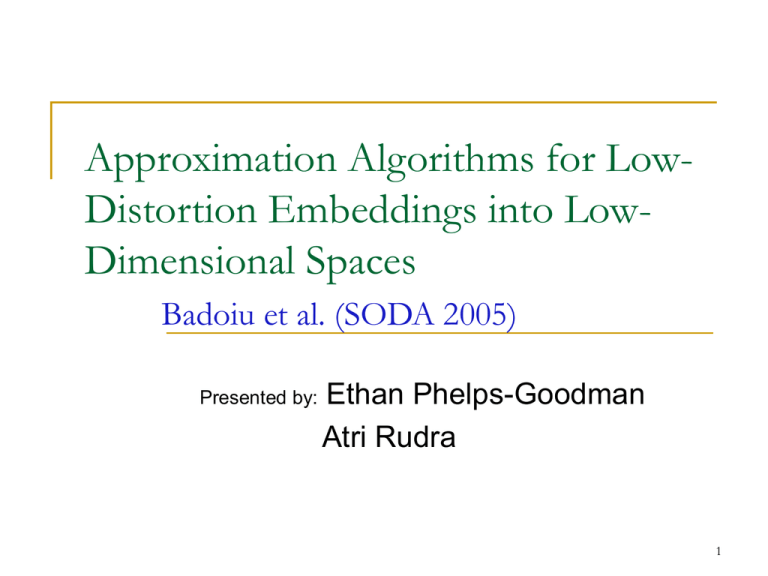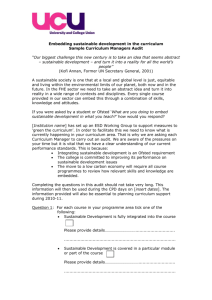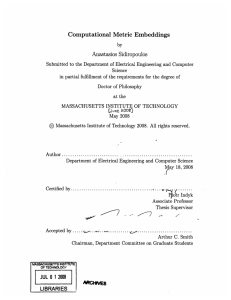Approximation Algorithms for Low- Distortion Embeddings into Low- Dimensional Spaces
advertisement

Approximation Algorithms for LowDistortion Embeddings into LowDimensional Spaces
Badoiu et al. (SODA 2005)
Presented by:
Ethan Phelps-Goodman
Atri Rudra
1
Moving from Seattle to NY
Looks like a 2hr drive
Looks like a 10hr plane ride
Contraction is bad
Expansion is bad
“Faithful” representation
2
Metric Spaces
Set of points
Distance function
Non-negative
Triangle Inequality
Metric Graph
1
2
3
5
6
5
weighted graph
shortest path distance
3
Embeddings
(Y,d2(¢,¢))
(X,d1(¢,¢))
Mapping : X! Y
Exp()=maxa,b2 X d2((a),(b))/d1(a,b)
Contr()=Exp(-1)
Dist()=Exp() with Contr()¸ 1
4
Edge property
Mapping from a unwt graph G=(V,E)
Exp()=max(x,y)2 E d2(x’,y’)
Exp()=maxx2 V,y2 V d2(x’,y’)/d1(x,y)
¸ is obvious
x=v1,v2,,vL=y be the shortest path in G
maxi d2(v’i,v’i+1)¸ 1/L¢ i d2(v’i,v’i+1)
The sum ¸ d2(x’,y’) by triangle inequality
5
Embedding into a class of metrics
Pick an embedding
Non-contractive
Minimum distortion
Embedding into specific
Metric [KRS04],[PS05]
6
Previous work
Start with a problem in some metric space
Embed inputs into another “nice” metric
Combinatorial in nature
Problem is easy to solve in the nice metric
For e.g., embed graphs into trees
Try to upper bound the distortion
Survey by Indyk
D
7
Algorithmic Task
Find embedding with min possible distortion
Don’t care about the value of distortion
Recall the map example
Embed unweighted graph into R (line) as well as possible
8
What is in store for you ?
Embed unwt graph ! Line
Hardness of the algorithmic Q
Approx Algo for general unwt graph
Approx Algo for unwt tree
What else is there in the paper ?
Open problems
9
Hardness of Approximation
NP-Hard to a-approximate for some a>1
Reduction from TSP on (1,2)-metric
All distances are in {1,2}
NP-Hard to a-approximate for any a <5381/5380
(X,D) ) G=(X,E)
D(u,v)=1 (u,v)2 E
10
Hardness of Approximation
TSP on (1,2)-metric
Input M:- (V,D(¢,¢))
Output:- Permutation of V which is a tour
M G=(V,E)
G
x
y
D(x,y)=1 (x,y)2 E
11
The Construction
G
Given metric M G
Make a copy of G called G’=(V’,E’)
Add a special node o connected to V[ V’
The constrcuted graph H has diameter=2
12
Showing that it works
M has a tour of len t) H embeds into R with distr · t
Let the tour be v1,v2,,vn,v1
Start with v1
Lay out v2,,vn according to their distances
Put in o
Lay out G’ in the same way as G
Non-contractive
Expansion=t
v1
0
v2
vi
vi+1
D(vi,vi+1)
vn
v’1
o
1
v’n
R
1
13
The other direction
f embeds H into R w/ distr s ) 9 tour in M of len ·s+1
Let u1,,u2n be the ordering of V[ V’ by f
Assume “nice” ordering
|f(u2n)-f(u1)|· 2s
(Wlog) blue box · (2s-2)/2=s-1
Blue box gives a tour of length · (s-1)+2=s+1
¸1
R
f(u2n)
f(u1)
14
Getting a nice ordering
Total ‘span’ still · 2s
“Boundary” nodes are at distance ¸ 2
Swap blue and green boxes
Total Span still · 2s
Still non-contractive
Keep on swapping till nice ordering is reached
¸2
R
15
What is in store for you ?
Embed unwt graph ! Line
Hardness of the algorithmic Q
Approx Algo for general unwt graph
Approx Algo for unwt tree
What else is there in the paper ?
Open problems
16
Embedding a tree into R
Create an Eulerian tour
Embed according to tour
preserve order
preserve distances
No contraction
Distortion · 2n-1
17
Embedding general graphs
Every graph embeds into R w/ O(n) distortion
Coming Soon: c-approx algo
Use any spanning tree
c is the value of the optimal distortion
Combining both gives O(n1/2)-approx
If c· n1/2, c-approx algo works
If c> n1/2, spanning tree algo works
18
c-approx algorithm
Embed G=(V,E) into R
Let f* be the optimal embedding
Let t1,t2 be the ‘end-points’ of f*
t1=v1,v2,,vL=t2 shortest path
V=V1[ V2 [ VL
x closest to vi ) x2 Vi
19
c-approx algo (contd.)
V1
V2
VL-1
Vi
VL
R
|Vi|
|Vi|
Embed Vi (i=1, L) by the spanning tree algo
2|Vi|
Layout vi first
Recall that the max span is · 2|Vi|
Leave a gap of |Vi| on each side
Run for all possible values of t1 and t2
20
Notations
f* is the optimal embedding
c is the optimal distortion
f is the computed embedding
D(¢,¢) shortest path in G
21
Analysis
V1
Vi
V2
x
y
|Vi|
2|V
i| |
4|V
i
|Vi|
Clm1: D(vi,x)· c/2
Clm2: |Vi|+|Vi+1|++|Vi+c-1|· 2c2
f* has distortion c
Clm3: Embedding is non-contracting
Will now show |f(x)-f(y)|· 16c2
VL
Vj
R
VL-1
|i-j|· 2c as D(vi,vj)· D(x,vi)+D(x,y)+D(y,v+j)· c/2+1+c/2
Span= 4¢[ (|Vi|++|Vi+c-1|) + (|Vi+c|++|Vj|) ]
The constructed embedding has distortion O(c2)
22
Non-contractive embedding
V1
Vi
V2
x
y
y
VL-1
VL
Vj
R
|Vi|
2|Vi|
|Vi|
x,y2 Vi
x2 Vi, y2 Vj
|f(x)-f(y)|¸ |Vi|
Should be |Vj|+1
(root goes first)
+ 2(|Vi+1|+ |Vj-1|) +|Vj|
¸ |Vi|
+ |j-i|
¸ D(x,vi) + D(vi,vj)
¸ D(x,y)
+ |Vj|
+ D(vj,y)
23
Proof of Clm1
vj
vi
Vj+1
x
R
f*(vj)
f*(vi)
f*(vj+1)
2¢ D(x,vi) · ? c
D(x,vi) + D(x,vi)
· D(x,vj)+D(x,vj+1)
· ( f*(vj) – f*(x) ) + ( f*(x) – f*(vj+1)
= f*(vj) – f*(vj+1)
·c
24
Embedding Trees into the line
Problem: Given an unweighted tree that
embeds into the line with distortion c, find the
smallest distortion line embedding.
They give (c logc)1/2-approximation,
Can also be stated as O((n logn)1/3)approximation:
If c > n2/3 then use simple spanning tree algorithm
If c < n2/3 then use this algorithm
25
Tree Embeddings
Similar to previous
algorithm
Select endpoints &
compute shortest
path
26
Tree Embeddings
Similar to previous
algorithm
Select endpoints &
compute shortest
path
Group every c
vertices
Embed each
component, then
concatenate
27
Local Density
Define local density by
Then c > .
= maxv, r (|B(v, r)|-1)/2r.
In max density ball, there are 2r vertices, so end
points of embedding have distance at least 2r.
But max distance is 2r, so endpoints have
distortion at least .
Also, any component with diameter d has at
most d vertices.
28
Component Embedding
Note: only care about order of vertices.
Distances computed from shortest path
Want to embed in roughly depth-first order
But don’t want neighbors too far away
Algorithm alternates between laying out
neighbors of previously visited vertices (BFS)
and DFS.
29
Component Embedding in action
Ci
30
Component embedding algorithm
Magic number g(c)= 2(clogc)1/2 + c
Pick a leftmost vertex r
Let Ci be vertices visited up to round i
While there are unvisited vertices
Visit all neighbors of Ci
Visit next g(c) vertices in light-path DFS order
31
Bounding the distortion
Outline:
Bound number of iterations
Bound span of neighbor step
Bound total distortion in component
Bound distortion from concatenation
32
Number of iterations
Diameter of tree is at
most 2c:
So total # vertices is
2c
At least g(c) added at
each iteration
Number of iterations is
(2c)/g(c) (clog-1c)1/2
c
c/2
c/2
33
Distortion of neighbor set
or, where did g(c) come from?
Claim: neighbor set is spanned by tree of size
g(c).
Idea: Vertices in neighbor set can’t be too far
from “active” DFS vertices:
at most (i+1) < (clog-1c)1/2 away.
So spanned by tree of size (clog-1c)1/2
2c2 vertices in component, so 2logc can be
active
2logc * (clog-1c)1/2 + c = g(c).
34
Distortion for full component
Vertices added in neighbor step are spanned
by tree of size g(c)
g(c) connected vertices added in DFS step
So distortion at most 2g(c) for each iteration
2 adjacent vertices could be on opposite
ends of iteration i and i+1, so total distortion
4g(c) over all iterations
35
Concatenating the embeddings
There is only one edge (vi, vi+1) connecting
components Xi and Xi+1
Modify the DFS ordering of Xi so that vi is last
visited
Doesn’t affect distortion of Xi, and distortion
of edge (vi, vi+1) is at most 2g(c)
Total distortion is at most
4g(c) = 8(clogc)1/2 + 4c 8 c3/2log1/2c + 4c
Or O((c logc)1/2) times optimal
36
Other algorithms in paper
An exact algorithm for embedding a general
graph into the line, with runtime O(nc).
A geometric 3-approximation for embedding
the sphere into the plane.
37
Open questions
For lines:
Better approximation ratios
Lower bounds
Weighted graphs (with large distortion)
Bigger question: algorithmic embeddings of
graphs into the plane.
38






